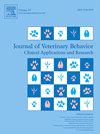Exploring the profile, management, and care of horses in equine-assisted services in Brazil
IF 1.3
3区 农林科学
Q4 BEHAVIORAL SCIENCES
Journal of Veterinary Behavior-clinical Applications and Research
Pub Date : 2025-03-01
DOI:10.1016/j.jveb.2025.01.009
引用次数: 0
Abstract
There is limited research on the profile and care of horses used in equine-assisted services (EAS), as well as the underlying causes of health issues in these animals. An online survey was sent to all 369 equine therapy centers affiliated with the Brazilian Association of Equine Therapy between September and December 2022. The survey included questions on the EAS program (10), horse health management (10), and horse demographics (6). A total of 65 centers (17.6%) responded, representing 393 horses (6.0 ± 5.1 per center): 65.4% were castrated males, 32.8% mares, and 1.8% stallions, aged 6.3–22.5 years. The most common breeds were saddle horses (60%), Quarter Horses (31%), draft horses (4%), ponies (3%), and Thoroughbreds (2%). Of the horses, 43% were purchased for EAS, 41% were donated, and 15.4% were rented. Respondents reported moderate to weak correlations between back pain and front (P < 0.01, r = 0.511) and hind limb lameness (P < 0.01, r = 0.411), hoof abscess (P = 0.020, r = 0.256), hoof cracks (P = 0.033, r = 0.229), and mean age (P = 0.014, r = 0.271). A weak negative correlation was observed between back pain and the frequency of odontological care (P = 0.018, r = −0.261). This survey provides initial insights into the health and management of EAS horses in Brazil, identifying key areas for further investigation to improve welfare and practices.
探索概况,管理和照顾马在巴西马辅助服务
关于马辅助服务(EAS)中使用的马的概况和护理以及这些动物健康问题的潜在原因的研究有限。在2022年9月至12月期间,向巴西马治疗协会附属的所有369个马治疗中心发送了一份在线调查。调查包括EAS计划(10)、马健康管理(10)和马人口统计(6)等问题。共有65个中心(17.6%)回应,代表393匹马(每中心6.0±5.1匹):65.4%是阉割的公马,32.8%是母马,1.8%是种马,年龄在6.3-22.5岁之间。最常见的品种是马鞍马(60%),四分之一马(31%),牵马(4%),小马(3%)和纯种马(2%)。在马匹中,43%为EAS购买,41%为捐赠,15.4%为租用。受访者报告背部疼痛和前部疼痛之间存在中度至弱相关性(P <;0.01, r = 0.511)和后肢跛行(P <;0.01, r = 0.411)、蹄脓肿(P = 0.020, r = 0.256)、蹄裂(P = 0.033, r = 0.229)、平均年龄(P = 0.014, r = 0.271)。背部疼痛与牙科护理频率呈弱负相关(P = 0.018, r = - 0.261)。这项调查提供了对巴西EAS马的健康和管理的初步见解,确定了进一步调查的关键领域,以改善福利和做法。
本文章由计算机程序翻译,如有差异,请以英文原文为准。
求助全文
约1分钟内获得全文
求助全文
来源期刊
CiteScore
3.50
自引率
16.70%
发文量
107
审稿时长
325 days
期刊介绍:
Journal of Veterinary Behavior: Clinical Applications and Research is an international journal that focuses on all aspects of veterinary behavioral medicine, with a particular emphasis on clinical applications and research. Articles cover such topics as basic research involving normal signaling or social behaviors, welfare and/or housing issues, molecular or quantitative genetics, and applied behavioral issues (eg, working dogs) that may have implications for clinical interest or assessment.
JVEB is the official journal of the Australian Veterinary Behaviour Interest Group, the British Veterinary Behaviour Association, Gesellschaft fr Tierverhaltensmedizin und Therapie, the International Working Dog Breeding Association, the Pet Professional Guild, the Association Veterinaire Suisse pour la Medecine Comportementale, and The American Veterinary Society of Animal Behavior.

 求助内容:
求助内容: 应助结果提醒方式:
应助结果提醒方式:


